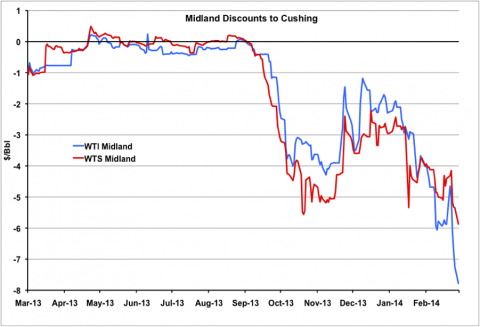This RBN piece characterizes many situations that many have found to be too complex........Eight Bucks Low in the Permian – Midland Discount to Cushing Blows Out
Primary tabs View(active tab) Group
published by Sandy Fielden on Tue, 03/11/2014 - 20:00
Prices for West Texas Intermediate (WTI) crude at Midland, TX -- close to the Permian Basin production region -- traded at a discount of $7.78/Bbl to WTI at Cushing, OK on Monday of this week (3/10/14), even though the pipeline tariff between the two trading hubs is less than $1/Bbl. Soaring production and tight pipeline capacity out of West Texas mean small changes in the region’s supply balance can cause the discount to blow out - a situation expected to continue at least until the middle of 2014. Today we investigate the probable causes.
The Permian Basin in West Texas and New Mexico has produced prolific quantities of crude since the 1920’s. And after declining slowly since the 1980’s the basin has been rejuvenated in recent years by enhanced recovery techniques including the application of horizontal drilling and hydraulic fracturing to the multi-layered “pancake” hydrocarbon bearing source rocks. Production has increased by over 400 Mb/d since the start of 2012 and is expected to increase another 500 Mb/d by the end of the decade. We have previously covered the growth in production and build out of pipeline capacity to get Permian crude to market – starting in 2012 with our “ New Adventures of Good Ole Boy Permian” series. Last year (2013) in our “Rock the Basin” series we covered plans to open up new takeaway capacity (see Tight Pipeline Balance) and the market impact of new pipelines to Houston (see Opening the Permian Crude Floodgates and Can Houston Refineries Absorb New Permian Crude Supplies?). Although the Magellan Longhorn and Energy Transfer West Texas Gulf expansions between them added 335 Mb/d of new pipeline capacity out of the Permian in 2013, there is still not enough room to comfortably ship growing production until the new Permian Express (200 Mb/d) and BridgeTex (278 Mb/d) pipelines come online in the middle of this year.
The current balance between pipeline capacity and crude trying to find it’s way to market is extremely tight. Competition for space on the pipelines out of the region has led to producers having to accept large discounts for their crude. Figure 1 below shows prices for WTI at Midland (blue line) and sister Permian crude West Texas Sour (WTS – red line) versus prices for WTI at Cushing, OK – the Midwest trading hub that is the delivery point for the CME NYMEX crude futures contract. Between March and September 2013 the spreads to WTI traded in a narrow range – close to the pipeline cost of transport between Midland and Cushing ($0.69/Bbl). Since September the discount has widened out – reaching $5/Bbl in October. More recently WTI Midland has been discounted by almost $8/Bbl against Cushing. The increased discounts in the past 6 months are not unique. The Midland/Cushing spreads blew out even more dramatically to over $20/Bbl in the fall of 2012 before the Longhorn pipeline opened up new capacity to Houston in early 2013. But before that during the eight years from 2004 to 2011 the WTI Midland discount to Cushing averaged just $0.22/Bbl.

Figure 1; Source: CME data from Morningstar (Click to Enlarge)
These big crude discounts generally mean only one thing - constraints getting production to market are causing producers to take a haircut to make their crude attractive enough to shippers. Yet looking at the capacity supply balance on paper the situation right now is tight but not severe. Figure 2 is an update to the transportation “Stack” diagram we built last year. The thick green line is the current and forecast Permian crude production (source Bentek). The takeaway options are then layered on top of each other in a stack to illustrate the total capacity versus production. At the bottom of the stack in red is local refinery consumption – the nameplate capacity of the four refineries in West Texas that consume Permian crude (more on them in a minute) – that accounts for 444 Mb/d. Next up in the stack in green is the 450 Mb/d capacity Plains All American Basin pipeline that runs from Midland to Cushing, followed by Occidental’s 140 Mb/d Centurion line (purple) also headed to Cushing and Energy Transfer’s West Texas Gulf pipeline (blue) expanded to 340 Mb/d last June (2013) that runs to the Midwest (Mid Valley pipeline) and Nederland on the Gulf Coast. Then comes the 225 Mb/d Magellan Longhorn pipeline (orange) that came online to Houston in 2013. On top of these existing pipelines is rail loading capacity (light purple) that we estimate to be 80 Mb/d. All these existing options in the stack amount to about 1.7 MMb/d – about 150 Mb/d higher than production estimated at 1.55 MMb/d in February 2014.

Figure 2; Source: RBN and Bentek (Click to Enlarge)
And in fact if you look at the black dashed lines on Figure 2 you can see that - on paper at least -production only gets really tight with capacity in June of 2014 – just as the new Energy Transfer 200 Mb/d Permian Express Phase II (gray blue layer on the chart) and Magellan/Occidental 278 Mb/d BridgeTex (pink layer) pipelines are expected online to relieve the congestion.
In the meantime however the reality on the ground tells a different story to the paper “stack” for a number of reasons as follows:
- Refineries do not run at full capacity – especially during maintenance: Local crude consumption by the four refineries in our stack is typically a lot less than their nameplate 440 Mb/d capacity. In fact the 70 Mb/d Alon Big Spring, TX; 128 Mb/d Western Refining El Paso,TX;100 Mb/d Holly Frontier Artesia, NM; and 146 Mb/d Phillips 66/Cenova Borger, TX (146 Mb/d) have frequently lost capacity due to various periods of scheduled maintenance (see Turn Around for more on refinery maintenance). So even though inland Texas refineries ran at over 95 percent of capacity in December according to the Energy Information Administration (EIA) the combined crude consumption of these four refineries has likely fallen consistently below 400 Mb/d over the past six months.
- Pipelines do not run at full capacity: For various operational and scheduling reasons, pipelines do not run at full nameplate capacity all the time. Sometimes they undergo routine maintenance. For example the newly reversed Longhorn pipeline is running at 200 Mb/d capacity – 25 Mb/d under nameplate in the first quarter of 2014 due to maintenance, according to operators Magellan. And even without maintenance large pipelines rarely run full all the time. We looked at data from our friends at Genscape who track pipeline flows in key US pipelines. Their numbers show that over the past year the 450 Mb/d Basin pipeline flows averaged 362 Mb/d and the 140 Mb/d Centurion pipeline flows averaged 93 Mb/d. When there is a surplus of capacity available these operational fluctuations can be absorbed by the system. When capacity is tight like it is in the Permian today, they make a bad situation worse.
- Rail Options to the Gulf Coast are not currently economic: Although the recent blow out in the Midland spreads has led to some increase in crude by rail traffic out of the Permian Basin, the additional costs have yet to make this option economic to the Gulf Coast. Our understanding is that until the spreads between Midland and Light Louisiana Sweet (LLS) crude at the Gulf Coast consistently exceed $10/Bbl (as they did in 2012), the arbitrage for crude by rail in that direction will stay closed. For the past two weeks the spread between Midland WTI and LLS has hovered around the $10/Bbl mark prompting some rail movement but don’t expect to see a big migration to rail until the spread widens out further.
- Rail Options to the West Coast are not currently economic for WTS: The spreads between Midland prices and Alaska North Slope (ANS) - the West Coast crude benchmark - over the past two weeks have been wider than for the Gulf Coast – averaging $12/Bbl for WTS and nearly $15/Bbl for WTI Midland. We previously estimated rail costs from the Permian to the West Coast at $8-10/Bbl plus terminal and freight charges of perhaps $4/Bbl – meaning total rail costs to the West Coast would be $12-14/Bbl (see Is the Price of Freedom Too High). In that previous analysis we noted that WTS would be a good fit for California refineries currently processing ANS but that there would be less demand for WTI. So if the spread between Midland WTS and ANS opens up above $15/Bbl for any length of time then rail options will become viable.
In summary, with crude production surging and new pipelines coming online in fits and starts, Permian producers continue to experience tight takeaway capacity and crude price discounts. Small changes in the supply demand balance such as refinery maintenance and pipeline flow reductions can have a big impact on prices. Unfortunately for Permian producers, the safety net of rail transport does not kick in until discounts reach more than $10 for WTI versus LLS and $15/Bbl for WTS versus ANS – a phenomena we are quite likely to see before new pipelines come online mid-year – even more so if those pipelines are delayed. |







